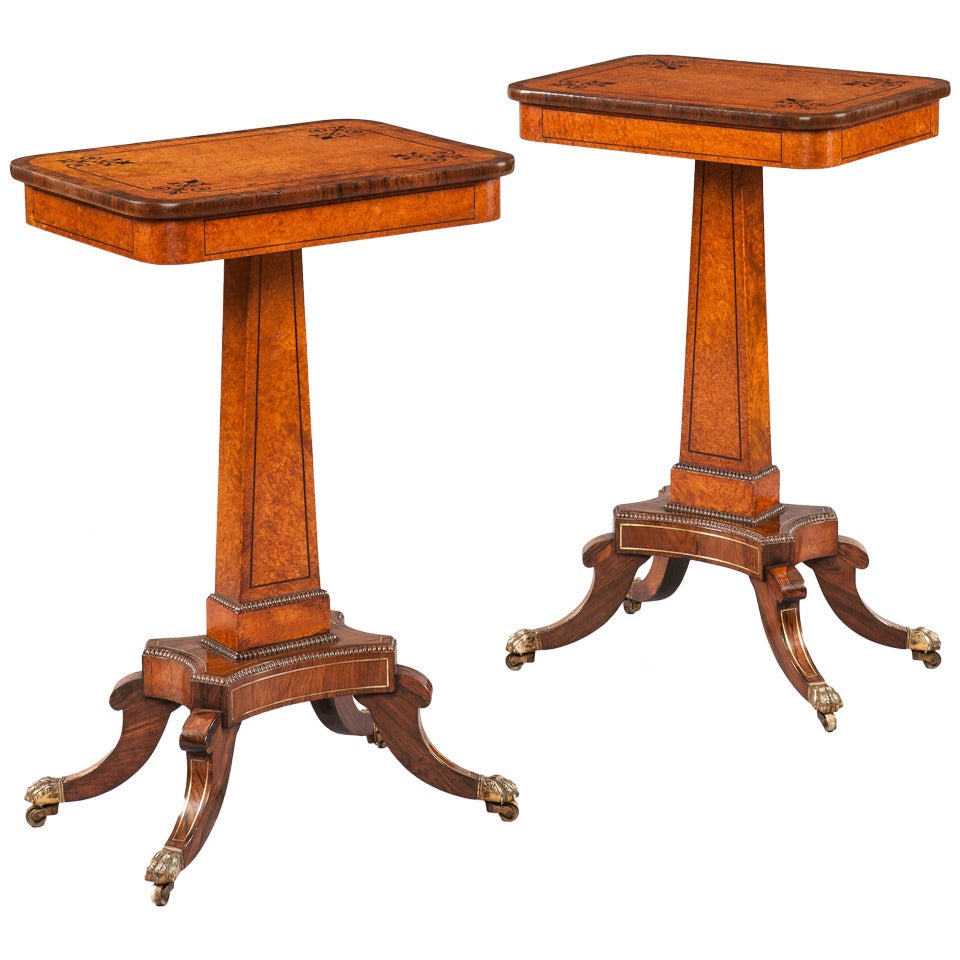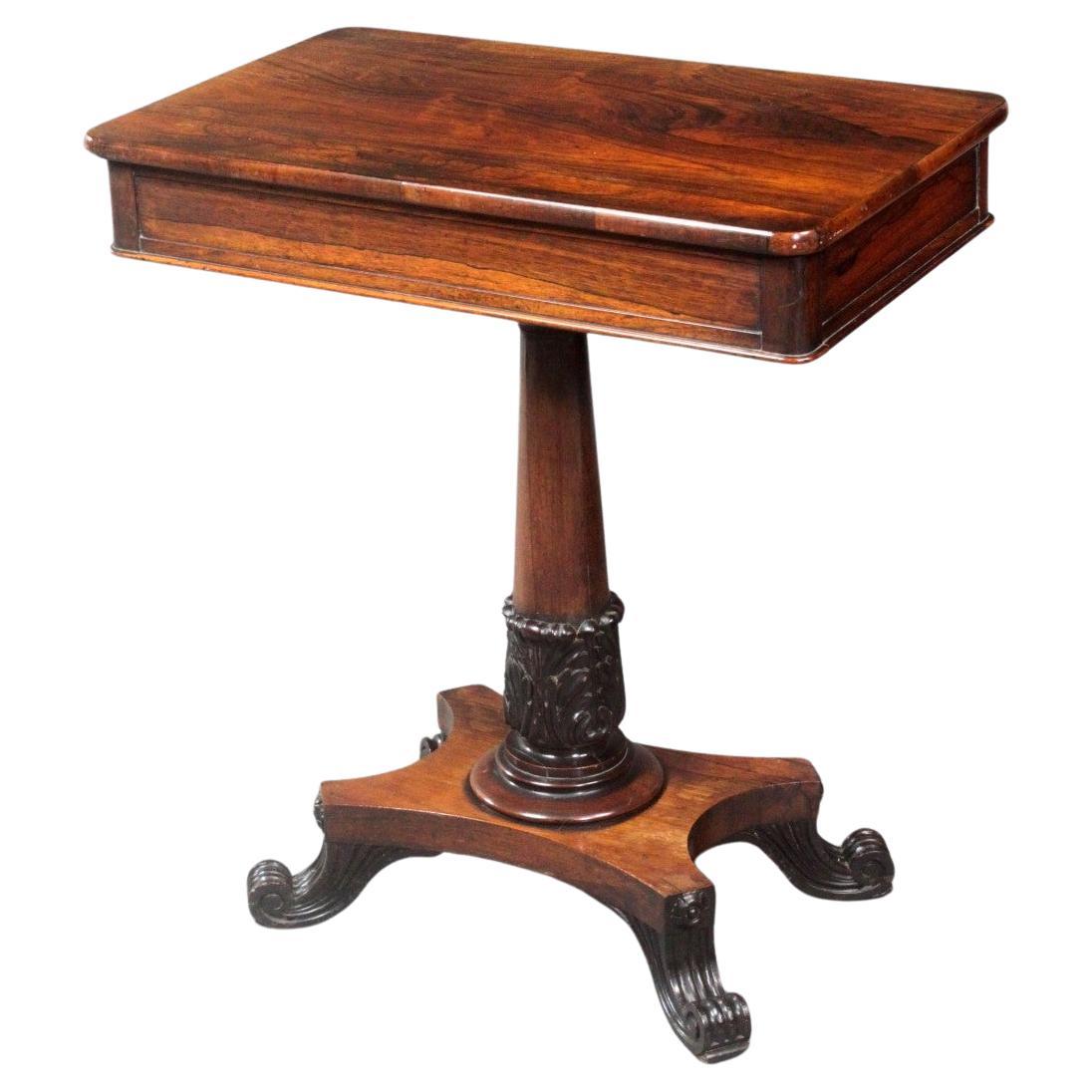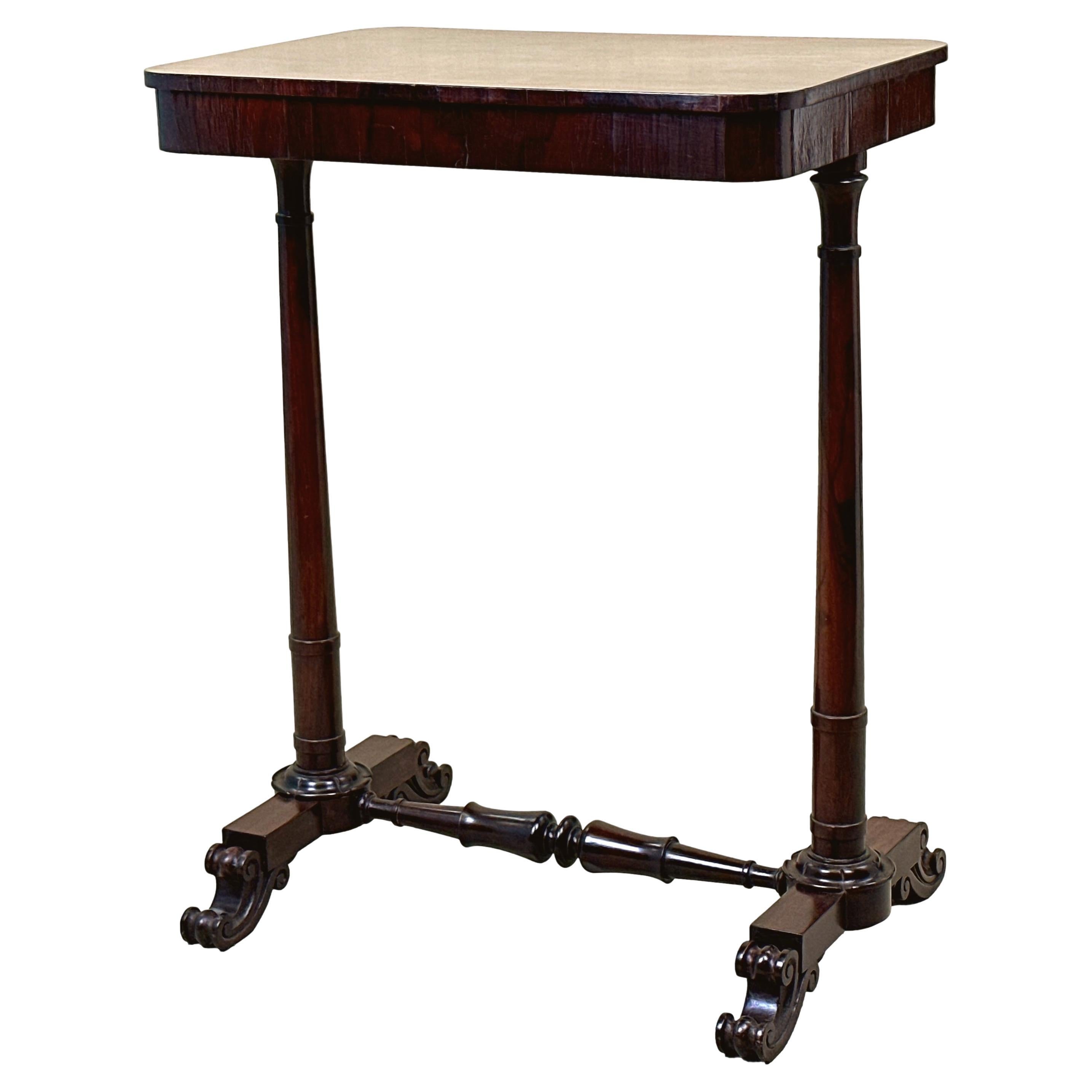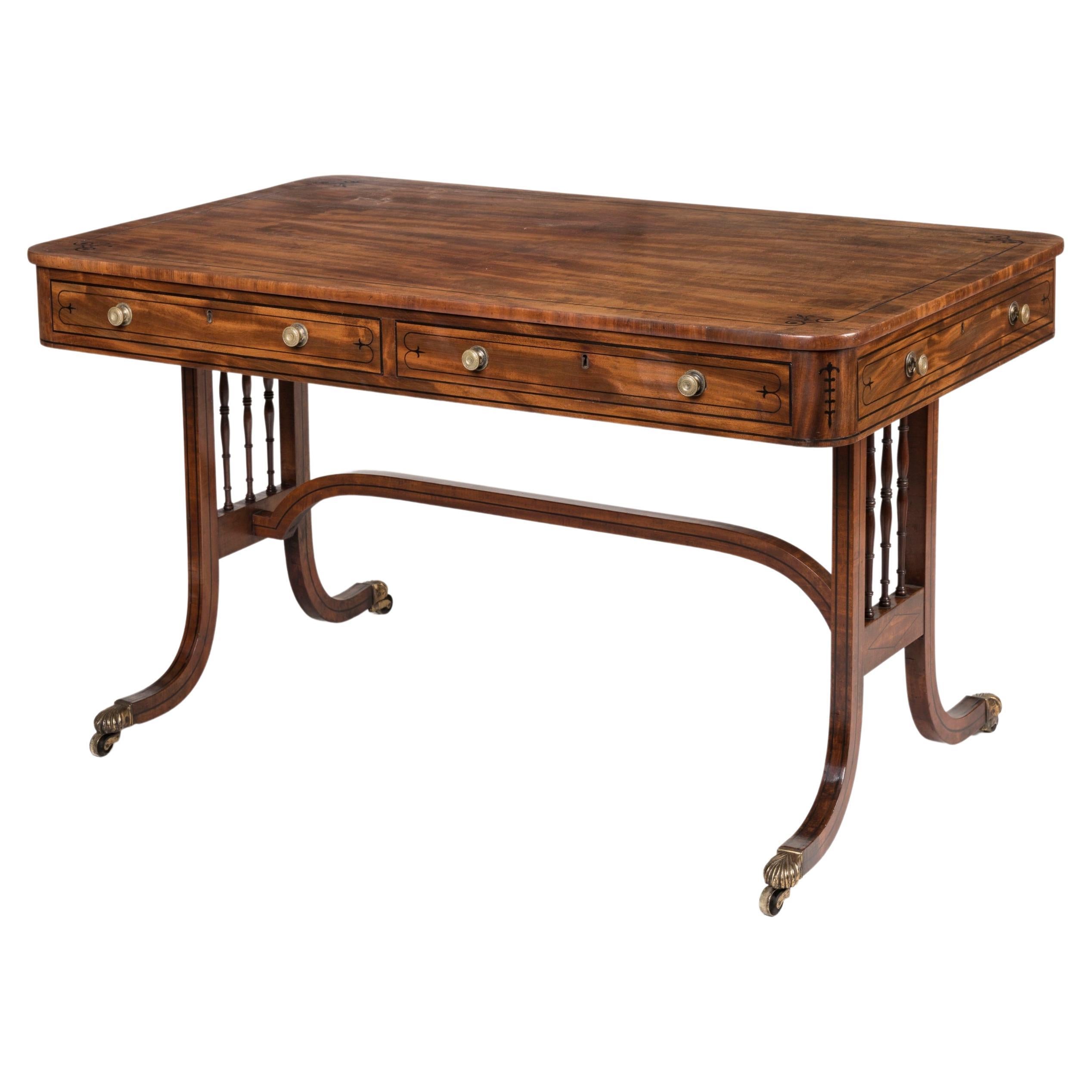Items Similar to An English Regency period penwork occasional table
Video Loading
Want more images or videos?
Request additional images or videos from the seller
1 of 6
An English Regency period penwork occasional table
About the Item
An English Regency-period chinoiserie penwork occasional table, circa 1815.
The unusual rectangular gentle-serpentine top profusely decorated, and centred by a chinoiserie scene of a man, woman and child, flanked by two large urns from which (possibly mulberry) vines are emerging, the whole surrounded by fine complex floral decoration with a chequer-work border. Raised on an ebonised base with elongated lotus on a concave quadruped base.
A chic antique.
A useful and attractive early-19th century table in lovely condition, in its original state.
Nb. Items decorated with penwork come in many shapes and sizes. The most common occur in the form of boxes and games tables with chequerboard tops, the less common in the form of small cabinets.
Penwork:
A form of decoration popular during the late-eighteenth and early-nineteenth centuries, and practised mostly by amateurs along with japanning, needlework and drawing etc, usually by talented aristocratic ladies. The craze was for orientalist designs and much penwork followed this pattern as well as with scenes from classical antiquity. Penwork was executed with fine quill pens and brushes showing charming, often naive subjects reflecting the amateur nature of the artist. Chessboard tops are a common subject. Layers of varnish would have originally been applied for protection.
Penwork is considered very stylish and much favoured by top interior designers and collectors alike. Condition is important as penwork can be costly to restore.
In June 1810, bookseller Rudolf Ackermann, owner of 'The Repository of the Arts' in the Strand, London, published the first known reference to penwork decoration in his periodical, referring to compositions with ''a black ground, in imitation of Indian ivory inlaid work.'' He supplied all necessary materials and equipment for customers to undertake the art of penwork, which at the time was primarily performed by women of a higher social standing who had time to devote to creative pursuits.
During the height of penwork popularity around 1820, the Prince Regent, George IV, had great influence over the decorative schemes present at the time, popularising chinoiserie decorations as seen in The Brighton Pavilion. Though penwork motifs could be procured from a variety of sources such as pattern books and other publications, many pieces were decorated by women working in their homes and therefore feature more unique decoration that may have been designed to match interiors, or even stemmed from their personal interest.
- Dimensions:Height: 28.15 in (71.5 cm)Width: 17.92 in (45.5 cm)Depth: 14.57 in (37 cm)
- Style:Regency (Of the Period)
- Materials and Techniques:Serpentine
- Place of Origin:England
- Period:19th Century
- Date of Manufacture:circa 1815
- Condition:Wear consistent with age and use. A useful and attractive early-19th century table in lovely condition, in its original state.
- Seller Location:Lymington, GB
- Reference Number:
About the Seller
5.0
Vetted Seller
These experienced sellers undergo a comprehensive evaluation by our team of in-house experts.
Established in 1957
1stDibs seller since 2018
33 sales on 1stDibs
Typical response time: 8 hours
- ShippingRetrieving quote...Ships From: Lymington, United Kingdom
- Return PolicyA return for this item may be initiated within 14 days of delivery.
More From This SellerView All
- Fine and Rare Regency Chinoiserie Occasional TableLocated in Lymington, GBA fine and rare English chinoiserie-decorated occasional table, circa 1820. The subject matter is extremely rare in that it depicts Europeans in exotic oriental robes. One is seated with an opium pipe; displayed in a polychrome romantic tropical environment with pavilions, rockwork, trellising, foliage, palms, with a peacock and HoHo bird at their feet. Note the very rare and charming depiction of these men with beards. In over 65 years we have never encountered a japanned table showing this European feature. Raised on a gilded, reeded, partly-ebonised column rising from a stylised platform base and spreading, gilded animal...Category
Antique 1820s British Chinoiserie Tables
MaterialsWood
- Fine Regency Mahogany Library Centre TableLocated in Lymington, GBA fine Regency period tilt-top brass inlaid mahogany and calamander library center table. Raised on a concave-sided triform base, with well-modelled cast-brass scrolling feet. Also referred to as a monopodium (table). All in excellent condition, well figured, and of very good rich color. Typical of designs by Thomas Hope (1769 - 1831). This form of antique table is also associated with work by George Bullock (1777 - 1818) and George Oakley (circa 1765 - 1841). Refs: A similar table with a leather insert, in the manner of Thomas Hope, circa 1800 - 1805, was sold in London for £39,650 - December 2010. This early 19th century table is reminiscent of the ‘Grecian’ style that the pioneering collector and designer Thomas Hope (1769-1831) popularized in Britain with the publication of ‘Household Furniture and Interior Decoration’ in 1807. Thos. Hope (banker, born 1769, d. 1831) The furniture manufacturer George Oakley (circa 1765-1841) was greatly influenced by Hope’s designs, and produced fashionable furniture in this style, using brass and star inlays similar to our table on offer. The firm’s designs and craftsmanship earned them royal patronage, and Oakley worked for the Prince Regent at Carlton House, as well as supplying furniture and upholstery for The Mansion House and The Bank of England. His work for the Cheere family - of Papworth Hall, Cambridgeshire, UK - is well documented. The reference to Geo. Oakley relates to a known table of this pattern in calamander wood and brass marquetry of starred-ribbon guilloche, which corresponds to the brass marquetry in a table supplied by Oakley in 1810 to Papworth Hall. Lit: Parker, R. 'History of Papworth Everard...Category
Antique Early 1800s English Regency Center Tables
MaterialsMahogany
- George III Period Satinwood Pembroke TableLocated in Lymington, GBA late 18th century satinwood Pembroke table of very good rich color. George III period. The top crossbanded in satinwood, bordered with fine lozenges of ebony stringing. The edges ebonized with narrow mahogany crossbandings. Raised on moulded tapering legs, indicative of a date circa 1770. The frieze with two working mahogany-lined short drawers retaining the original gilt-brass Rococo mounts. The two leaves are supported on the original recessed hinged ‘ear’ supports. Overall in lovely original state. Some minor historic marks entirely commensurate with its age. Very good patination. These antique Pembroke tables were designed to be versatile: as small supper tables; occasional tables; tea tables; or lamp tables - sometimes also referred to as ‘drop leaf’ or ‘sofa’ tables. The majority of these Georgian tables are raised on square tapering legs or, when of a later date, on turned legs. It is more unusual for a satinwood Pembroke table to be raised on moulded tapering legs. Interestingly, Thomas Sheraton (1751-1806) mentions the Pembroke table as follows: “a type of breakfast table from the name of the lady who first gave orders for one of them”, possibly referring to the Countess of Pembroke, of Wilton House, Salisbury, (1737-1831). A similar George III satinwood Pembroke table...Category
Antique 1770s English Tables
MaterialsSatinwood
- Queen Anne Period Walnut Games Card TableLocated in Lymington, GBAn early-18th century Queen Anne period carved walnut games, or card, table. Circa 1710. Veneered in well-figured walnut with herringbone feather bandings. The bold fold-over outset...Category
Antique 1710s English Card Tables and Tea Tables
MaterialsWalnut
- Large Regency Period Mahogany Dining TableLocated in Lymington, GBAn English Regency-period solid mahogany extending dining table of superb colour and figuring. Early-19th century, circa 1820. Retaining all of its original leaves of fine, well-figu...Category
Antique 1820s English Regency Dining Room Tables
MaterialsMahogany
- 17th Century Oak Refectory Table, Charles II PeriodLocated in Lymington, GBA rare English 17th-century oak refectory table. Charles II period, ca 1675. The three-plank cleated detachable top is of superb color, figuring and patination. Raised on six baluster supports united by stretchers. The frieze is guilloche-carved on all four sides: this demonstrates that this table can be free-standing. Many of these were only carved on three sides. This versatile refectory table can be used as a hall table, dining table, serving table, or a wonderful kitchen table. A number of early oak pieces which we have sold have harmonized very well with modern interiors. A similar-sized refectory table (in generally poor condition) sold for £17,000.00 plus buyer's premium, in Duke's auctioneers ATHELHAMPTON HOUSE sale, Puddletown, Dorset, UK, 9th Oct, 2019. Nb. The turning of the supports on this antique table indicates a development away from an earlier, heavy, carved bulbous leg, to a simpler baluster leg of the later-seventeenth century. However the guilloche-carved frieze is a hint of an earlier period. Some historic restoration commensurate with 350 years of use. Dimensions: 8’5’' L. (256.5 cm) 2’8’' W. (81 cm) 2'7'’ H. (79 cm). Literature: R. W. Symonds 'The Present State of Old English Furniture...Category
Antique 1670s Charles II Tables
MaterialsOak
You May Also Like
- Period Regency Rosewood and Brass Occasional TableLocated in Hudson, NYThis fine piece of furniture is made from rich deeply grained rosewood. Even the pedestal support is turned and carved from solid rosewood. The table is further accentuated with a wi...Category
Antique 19th Century English Regency Tables
MaterialsBrass
- Pair of British Regency Period Occasional TablesBy William TrotterLocated in London, GBA pair of antique Regency occasional tables in the manner of Trotter of Edinburgh Constructed in a well patinated Amboyna, adorned with Hollywood, goncalo alves and brass line inlays; rising from castor shod swept quadripartite legs having brass lions paw feet supporting the incurved platforms, dressed with a beaded reel...Category
Antique 19th Century British Regency Tables
MaterialsBrass
- Regency Rosewood Occasional TableLocated in Bradford-on-Avon, WiltshireAn attractive Regency rosewood occasional table with label inside for William Hean. Fine quality carved stem, scroll feet and Tudor rose patera. Note: Hean was active at his first p...Category
Antique 1820s English Regency Tables
MaterialsRosewood
- English Regency Penwork Games TableLocated in Stamford, CTPenwork games table with pedestal on four legs and wheeled feet, English, circa 1810.Category
Antique 1810s English Regency Game Tables
MaterialsWood
- Late Regency Rosewood Occasional TableLocated in Bedfordshire, GBA Good Quality, 19th Century, Late Regency Period Rosewood Occasional Lamp Table Of Diminutive Proportions, Having Well Figured Rectangular Top Raised On Elegant Turned End Supports,...Category
Antique Early 19th Century English Regency Center Tables
MaterialsRosewood
- Elegant English Regency Period Mahogany Table with Inlaid DetailsBy Gillows of Lancaster & LondonLocated in London, GBAn Elegant Regency Period Table Attributed to Gillow Constructed in a striking flamed Honduran mahogany: rising from brass castor shod swept and ebony strung legs, the ends housing...Category
Antique 19th Century English Regency Tables
MaterialsBrass
Recently Viewed
View AllMore Ways To Browse
Layered Table
Less Table
Less Less Table
Table Floral Decorations
Small Occasional Table
Antique Artist Work Table
Working Table With Cabinets
English Box Table
Social Table
English Occasional Table
Small Japanese Table
Antique Ivory Table
Small Antique Cabinet Table
Antique Pavilion
Inlaid Occasional Table
Ivory Inlaid Furniture
Ivory Inlaid
Antique Small English Table





